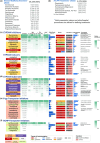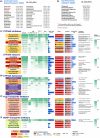Use of Real-World Claims Data to Assess the Prevalence of Concomitant Medications to Inform Drug-Drug Interaction Risk in Target Patient Populations
- PMID: 40170515
- PMCID: PMC12166264
- DOI: 10.1002/cpt.3652
Use of Real-World Claims Data to Assess the Prevalence of Concomitant Medications to Inform Drug-Drug Interaction Risk in Target Patient Populations
Abstract
A common issue in clinical drug development involves drug-drug interactions (DDI) that may lead to altered drug exposure and subsequent altered safety and efficacy of an investigational drug or concomitant medications (conmeds) in the target patient population. The drug development pipeline therefore involves DDI risk assessment of the investigational drug based on in vitro studies, in silico modeling, and clinical trials. Real-world data (RWD), particularly claims databases with reliable information on pharmacy dispensing, provide an opportunity to understand conmeds usage in the target indication in a real-world setting as one approach to assess potential DDI risk. We describe two cases of characterizing DDI-related conmeds usage with a large closed US-based claims database, IQVIA PharMetrics® Plus, and identified potential DDI risk for multiple sclerosis and hormone receptor-positive breast cancer. For example, prevalent and chronic use of statins (atorvastatin and simvastatin), which are CYP3A4 substrates, were identified among both disease cases. Further examples, limitations, and future directions are also discussed. These insights can therefore help augment decision-making during clinical drug research and development.
© 2025 Institut Roche SAS and Genentech, Inc. Clinical Pharmacology & Therapeutics published by Wiley Periodicals LLC on behalf of American Society for Clinical Pharmacology and Therapeutics.
Conflict of interest statement
All authors are employees or contractors of Genentech/Roche at the time of this work. As an Associate Editor for Clinical Pharmacology & Therapeutics, Amita Joshi was not involved in the review or decision process for this paper.
Figures



References
-
- Huang, S.‐M. et al. New era in drug interaction evaluation: US Food and Drug Administration update on CYP enzymes, transporters, and the guidance process. J. Clin. Pharmacol. 48, 662–670 (2008). - PubMed
-
- The US Food and Drug Administration . Clinical drug interaction studies—cytochrome P450 enzyme‐ and transporter‐mediated drug interactions guidance for industry <https://www.fda.gov/media/134581/download> (2020).
-
- The US Food and Drug Administration . In vitro drug interaction studies—cytochrome P450 enzyme‐ and transporter‐mediated drug interactions guidance for industry <https://www.fda.gov/media/134582> (2020).
-
- The US Food and Drug Administration . Framework for FDA'S real‐world evidence program <https://www.fda.gov/media/120060/download> (2018).
MeSH terms
Substances
Grants and funding
LinkOut - more resources
Full Text Sources
Medical

